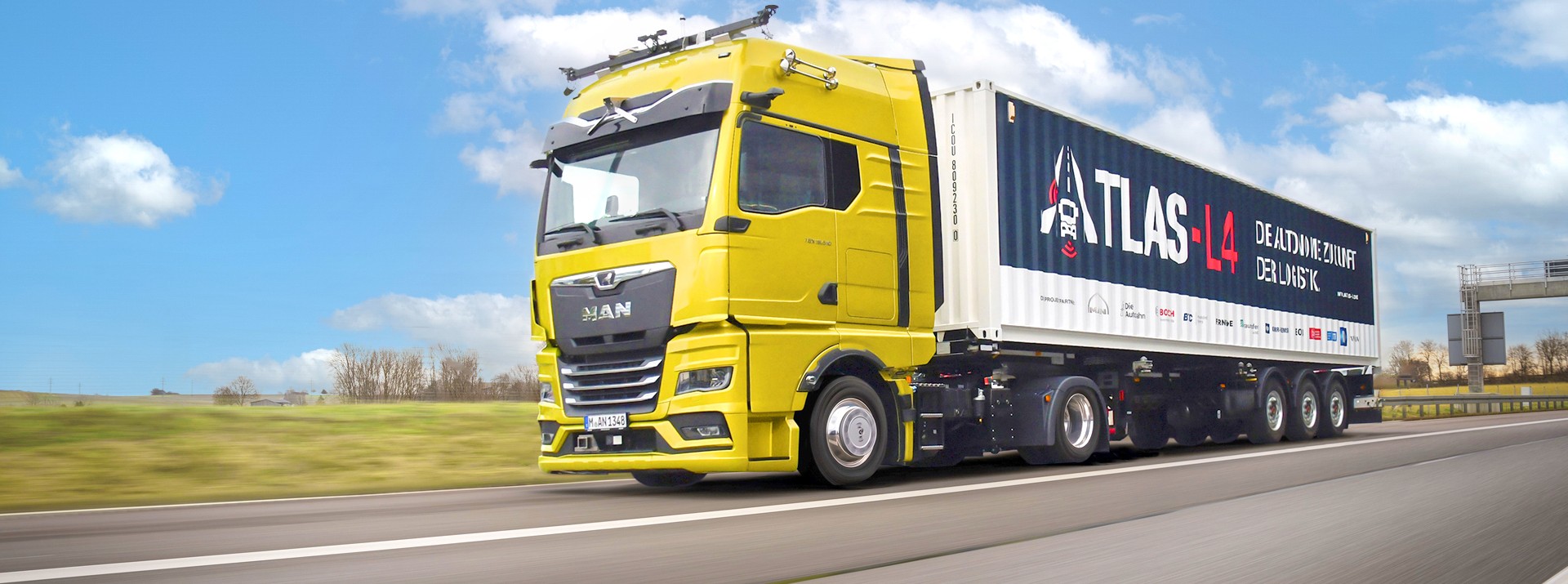
In terms of public attention, e-mobility has somewhat overshadowed automated driving. But can highly automated driving (HAD) for trucks be developed even more effectively while out of the limelight? Dr. Christoph Huber from Knorr-Bremse explains how Knorr-Bremse has successfully positioned itself as a specialist industry leader with its redundant braking system, among other innovations. Now, hub-to-hub transportation with attractive total cost of ownership could bring the eagerly awaited development step on the road to HAD series production. Might the self-driving truck even take to the highway before the autonomous car?
It was never a genuine race, but e-mobility had clearly overtaken highly automated driving in the commercial vehicle sector – in the competition for development budgets. Dr. Christoph Huber, Head of Advanced Driver Assistance Systems at Knorr-Bremse, spells out the reason for its prioritization: “E-mobility is a trend largely driven by society and is therefore at the forefront of public discourse, legislation and the transport industry. Nevertheless, a real business case will emerge in the long term as the total cost of ownership (TCO) falls. Meanwhile, highly automated driving is strongly driven by the direct benefit of economic efficiency, so the substantial investments in this technology will pay off more quickly.” Dr. Huber explains: “Fleet operators make their own choices on how to deploy automated driving to reduce costs and support their drivers. They reach these benefits through lower TCO, higher availability, higher transport safety and a way to tackle to the major problem of driver shortages.” In particular, falling total costs provide motivation for the ongoing development of HAD technology (see figure 1). HAD systems are currently still designed for combustion-powered trucks, but they will become part of the e-mobility platform in the longer term. As such, autonomous driving is not in competition with e-mobility, but will enhance it technologically.

Challenges for highly automated driving
The Level 4 HAD truck is expected to go into series production well before the end of the decade. Starting from the current Level 2, well-defined, economically promising use cases are now sought (see figure 2). To this end, market players from the areas of original equipment (OE), Tier-1 suppliers, and artificial intelligence (AI) have pooled their own competencies and found their position in the market. This consolidation also relates to certain business models that have stalled, Dr. Huber reflects briefly: “Numerous startups had recognized the need for autonomous driving to fill the driver gap and make fleet operations more economical. These young AI companies aimed to integrate supplied actuators into a truck and provide a road-ready vehicle. But they didn’t reach this goal. Obstacles included the high technological complexity of HAD, pressure on costs and the lack of economically viable applications.” The upshot was a reorganization of collaborative development projects in the market.

The market is positioned to act, but some unresolved challenges still accompany HAD development, explains Dr. Huber: “One hurdle is the commercialization of HAD technology for trucks that have a high number of variants, yet relatively low vehicle quantities. There are also legal uncertainties due to the lack of standardized validation and verification phases as well as pending legislation, e.g. on liability issues in the event of accidents. A third point is that autonomous driving has yet to reach a high level of social acceptance. People don’t fully trust the virtual driver as a safe road user.”
Knorr-Bremse has positioned itself in HAD
Knorr-Bremse operates as a specialized industry leader in its market segments for highly automated driving – and not as a complete systems manufacturer. A good basis, says Dr. Huber: “From this position, we can best drive forward the redundancy concepts for safety-critical subsystems of a Level 4 architecture. Our focus is clearly on the actuators, including the braking system, steering and power management system.” (see diagram 3)

Redundant braking system in operation
The redundancy functions of the subsystems are not merely based on duplicate components. Knorr-Bremse employs a smart and cost-efficient architecture that integrates the primary and secondary paths. In this way, existing components can be intelligently developed and equipped with new software and safety architecture. The approach makes it relatively easy for customers to upgrade their existing systems to L4 capability.
“With their two fallback levels, our redundant braking systems are thoughtfully developed to meet current and future customer and market requirements at all times,” says Dr. Huber. “The handling of fault signals from the truck during the journey is a good illustration.” In the event of a brake system failure, the vehicle manufacturer currently applies a Minimal Risk Maneuver. In other words, the truck is driven to the side of the road, parked and awaits assistance. Thanks to its scalable design, the redundant braking system can already meet the availability requirements for the more advanced Mission Complete solution. Here, if the braking system fails, the truck can fall back on a second braking system with equivalent performance and continue driving. Should another failure occur, the truck can still be safely parked using the Minimal Risk Maneuver.
Dr. Huber sees the forward-looking development work as the task of a technology leader like Knorr-Bremse: “As a systems specialist, we have developed for maximum performance, and we also support with decision-making by offering explanations and solutions to technical questions.” The approach can really pay off, as finalized transport journeys ensure timely delivery of intact goods, which is especially important for items such as perishable goods.
Knorr-Bremse’s redundant braking system is ready for the first market launches of highly automated trucks. “In this regard, we have a huge strength, namely our knowledge of all customer braking systems and their requirements. Building on this generic basis, we scale the specific solutions for customers,” explains Dr. Huber. He refers to positive talks and projects with lead customers, especially in Europe and North America. For example, near-series redundant sample components have already been installed in vehicles approved for road use, and the redundant braking system is also featured in the HAD development project ATLAS-L4.
ATLAS-L4 project motoring ahead
The ATLAS-L4 development project illustrates the move from the universal HAD concept to the specific use case. Twelve specialized partners are on board with ATLAS. The project is managed by vehicle manufacturer MAN Truck & Bus, which has already built several prototype vehicles. Knorr-Bremse is contributing the redundant braking system architecture, including steering redundancy through steer-by-brake, as well as the associated safety concept. After autonomous driving trials at MAN’s Munich test site, things are progressing rapidly: HAD testing on a German highway began in April 2024. The necessary control center for technical supervision was installed and a vehicle risk analysis accompanying the project was successfully completed. The ATLAS-L4 project aims to prove the feasibility of using Level 4 automated vehicles, and therefore driverless vehicles, on the highway. This would lay the foundation for future series applications in a Logistics 4.0 context.
Hub-to-hub use case
One candidate seems particularly fitting as a use case on the road to HAD series production: Level 4 hub-to-hub operation. It holds the promise of economic viability. A concrete example would be a truck making the journey from one distribution hub to another without a driver (see diagram 4).

In hub-to-hub operation, the aim is always to minimize the complexity of transport operations and technology. For this reason, the initial focus is on long-distance journeys on the highway rather than urban routes. The highway environment has lower requirements for trials and tests, as it excludes oncoming traffic and unprotected road users such as pedestrians and cyclists.
Collaboration on a hub-to-hub solution is conceivable in various constellations between OE, Tier-1 suppliers and AI companies, depending on the project. “Ultimately, the partners will each contribute their expertise to the vehicle and exchange in depth with one another via various interfaces,” says Dr. Huber.
Looking to the future
If the first series production autonomous truck hits the highway before the end of the decade, as planned, it could be one truck length ahead of the series production autonomous car. Or perhaps not. In reality, it is less about fulfilling the once futuristic vision of the driverless car and more about the practical and safe use of L4 vehicles. HAD development for commercial vehicles is progressing steadily and Knorr-Bremse is playing its part. The rGBSC redundant braking system is scheduled to be ready for series production by the middle of the second half of this decade, regardless of the expected order volume. In addition, Knorr-Bremse continues to develop the redundant steering system, with timing dependent on customer requirements, and the redundant power management system rPMS.
One important milestone will be the driver-out release for driverless trucks. This approval will enable vehicle manufacturers, together with their AI partners, to significantly ramp up testing of the HAD truck. The safety concept – including the redundant braking system – will then be a big step closer to series production.
Beyond that, Dr. Christoph Huber has exciting plans to announce: “Until the HAD truck is ready for series production, Knorr-Bremse will offer customers a product portfolio that is marketable from Level 2 to 4. During this long transition phase, functions could include a high-performance emergency braking assistant or high-performance AEBS (advanced emergency braking system). To this end, we are in close talks with selected customers who are equally passionate about advancing highly automated driving and getting it on the road!”

Dr. Christoph Huber
In almost 15 years at Knorr-Bremse, Dr. Christoph Huber has dedicated himself to topics including sensor technology for braking systems and, by leading the respective project and CoC, to the automated driving of commercial vehicles. Dr. Huber, who holds a doctorate in electrical engineering, is currently responsible for the Advanced Driver Assistance Systems unit at Knorr-Bremse.